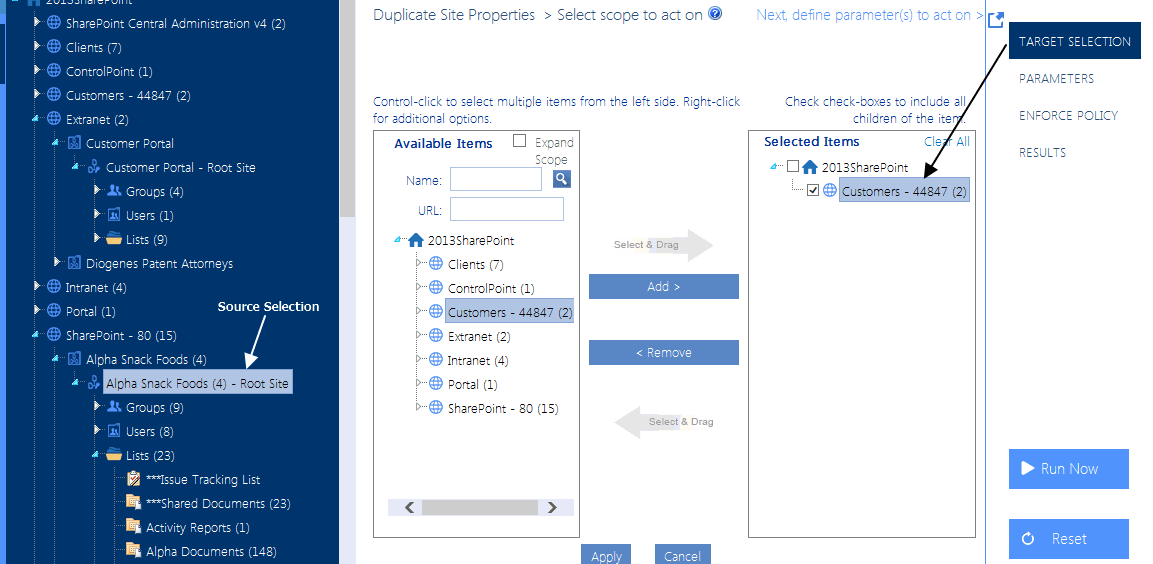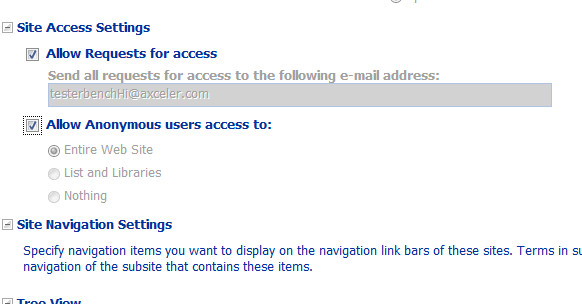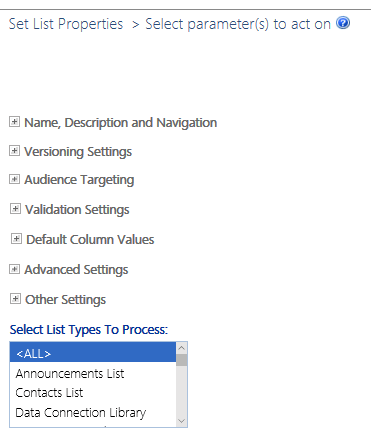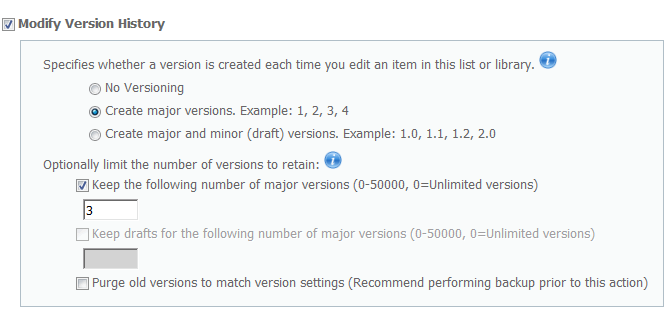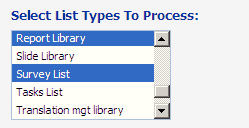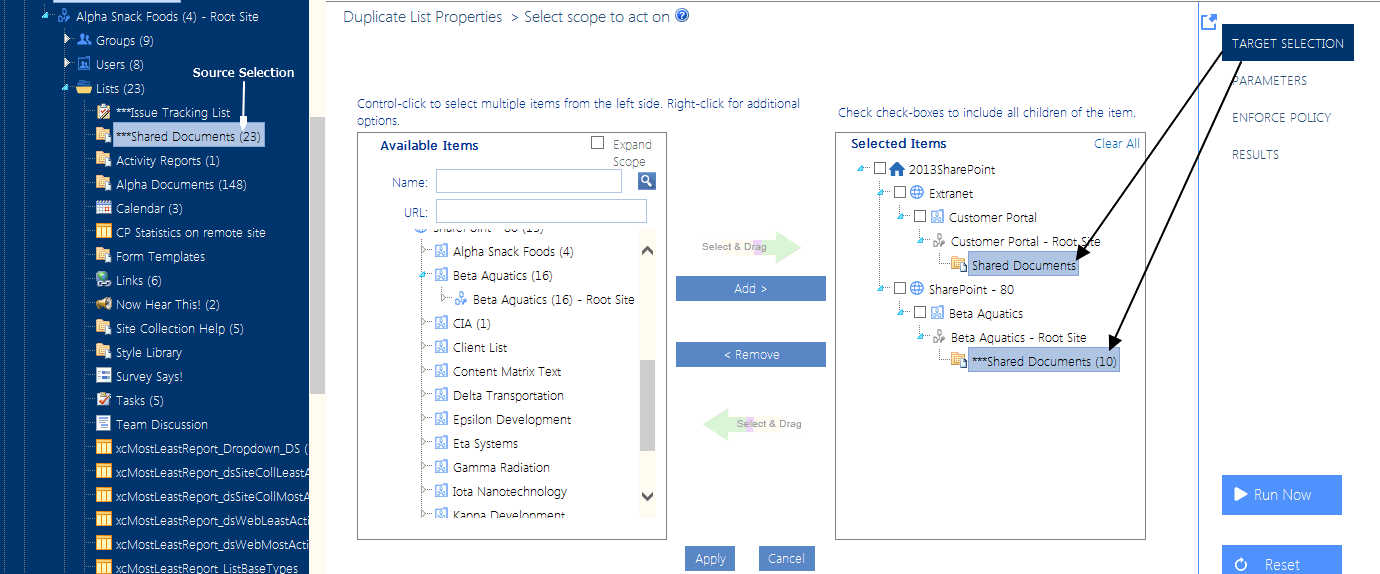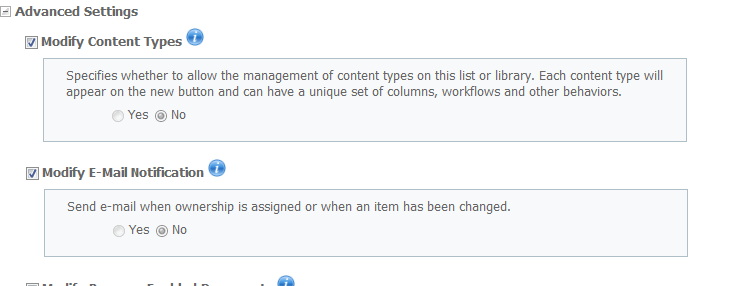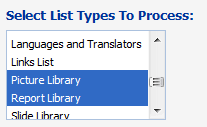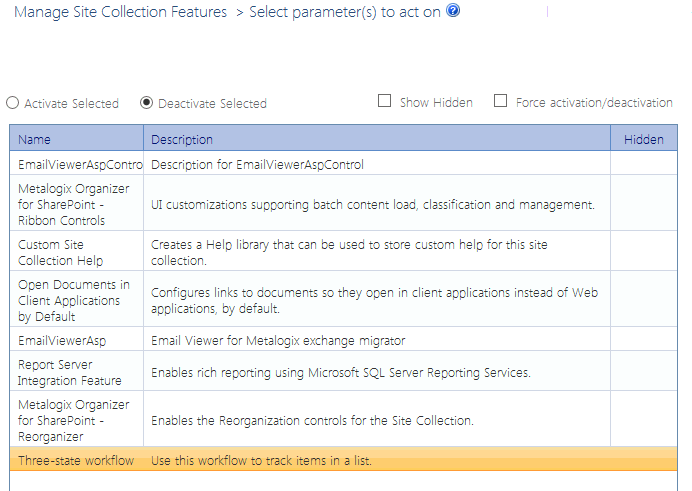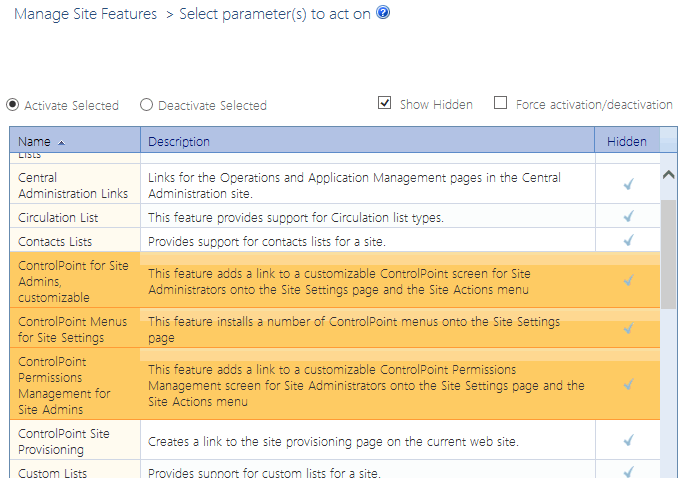Duplicating Site Properties
The Duplicate Site Properties action lets you copy selected properties from a SharePoint site to one or more other sites.
You can, for example, set up and configure a single model site, then copy its settings to any number of other sites for which you want to use the same settings.
To duplicate site properties:
1Select the site whose properties you want to duplicate.
NOTE: Unlike many other ControlPoint operationswhich are initiated for target objects (that is, objects that you want to act on)you initiate the Duplicate Site Properties operation by selecting the source site (that is, the site you want to copy from).
2Choose Configuration > Duplicate Site Properties.
3In the Target Selection picker, select the object(s) containing the site(s) that you want to copy properties to.
4Click [Apply].
5In the Parameters section, check each box that corresponds to the property you want to copy to the target site(s).
Note that, with the exception of Site Theme, each field pre-populates with the value currently assigned to the source site (that is, the value that will be applied to the target sites). These fields are not editable.
Now you can:
·run the operation immediately (by clicking the [Run Now] button)
OR
·complete the Enforce Policy section and schedule the operation to run at a later time.
OR
·save the operation as XML Instructions that can be run at a later time.
If you chose the Run Now, option, after the operation has been processed:
·a confirmation message displays at the top of the page, and
·a ControlPoint Task Audit is generated for the operation and displays in the Results section.
If you schedule the operation, a link to the Task Audit is included in the scheduled action notification email.
See also The ControlPoint Task Audit.
If you schedule the action, ControlPoint will use the settings that exist for the source object at the time the job is run (not at the time the job was created).
Setting List Properties
Use the ControlPoint Set List Properties action to set the following properties of one or more lists within a SharePoint farm:
·name, description, and navigation
·version settings
·audience targeting
·validation settings and default column values
·advanced settings.
You can also specify the list type(s) to which you want to apply the properties.
This feature is not available at the farm (tenant) scope.
To set list properties:
1Select the object(s) for which you want to set list properties.
2Choose Configuration > Set List Properties.
3In the Parameters section, expand the node for the category of properties you want to set.
4Check the box that describes the property you want to set.
NOTE: If you do not check the applicable property box, ControlPoint will not carry out that action.
5Specify the parameter(s) for the selected property as you would if you were setting it via SharePoint List Settings. Consult your SharePoint documentation for detailed information.
NOTE: The 
6Complete Steps 3-5 for each category of properties you want to set.
7If you want to limit the operation to one or more specific list types, Select List Types to Process.
If you chose the Run Now, option, after the operation has been processed:
·a confirmation message displays at the top of the page, and
·a ControlPoint Task Audit is generated for the operation and displays in the Results section.
If you schedule the operation, a link to the Task Audit is included in the scheduled action notification email.
See also The ControlPoint Task Audit.
Duplicating List Properties
The Duplicate List Properties action lets you copy selected properties from a SharePoint list to one or more other lists.
You can, for example, set up and configure a single model list, then copy its settings to any number of other lists for which you want to use the same settings.
To duplicate list properties:
1Select the list whose properties you want to duplicate.
NOTE: Unlike many other ControlPoint operationswhich are initiated for target objects (that is, objects that you want to act on)you initiate the Duplicate List Properties operation by selecting the source list (that is, the list you want to copy from).
2Choose Configuration > Duplicate List Properties.
3In the Target Selection picker, select the object(s) that you want to copy list properties to.
NOTE: If you select an object above the list level, you will have the option of limiting the operation to one or more specific types of list within that scope.
4Click [Apply].
5In the Parameters section, check each box that corresponds to the property you want to copy to the target list(s).
Note that:
§The Parameters section displays properties that are valid for the selected source list type.
§With the exception of Modify Retention Policy, each field pre-populate with the value currently assigned to the source list (that is, the value that will be applied to the target lists). These fields are not editable.
6If you want to limit the operation to specific types of lists, Select List Types to Process.
Now you can:
·run the operation immediately (by clicking the [Run Now] button)
OR
·complete the Enforce Policy section and schedule the operation to run at a later time.
OR
·save the operation as XML Instructions that can be run at a later time.
If you chose the Run Now, option, after the operation has been processed:
·a confirmation message displays at the top of the page, and
·a ControlPoint Task Audit is generated for the operation and displays in the Results section.
If you schedule the operation, a link to the Task Audit is included in the scheduled action notification email.
See also The ControlPoint Task Audit.
If you schedule the action, ControlPoint will use the settings that exist for the source object at the time the job is run (not at the time the job was created).
Managing Site Collection and Site Features
Manage Site Collection Features and Manage Site Features are ControlPoint actions that enable you to activate or deactivate features across one or more SharePoint site collections or sites. In addition to managing features that can be activated/deactivated via the SharePoint user interface, you can also activate/deactivate hidden features. (In SharePoint, hidden features must be activated/deactivated using a command line, custom code, or through dependency of another feature.)
You can use these actions in conjunction with the Site Collection Property Report and Site Property Report to manage the configuration of SharePoint features throughout your farm.
In a multi-farm environment, features can be managed across multiple farms; the user interface is populated with features that have been deployed on the home farm. Therefore, if your multi-farm installation includes different SharePoint versions (for example, both 2010 and 2013) or variations (for example, Foundation and Server), which necessitates differences in the user interface, some options may be missingor not validfor the remote farm. For example, if a feature is selected that has not been deployed on a remote farm, the activation or deactivation of the feature will be skipped for that farm.
To manage site collection or site features:
1Select the object(s) for which you want to manage features.
2Choose the appropriate option:
§Configuration > Manage Site Collection Features.
OR
§Configuration > Manage Site Features.
All of the available site collection or site-level features (depending on your selection) that can be activated/deactivated via the SharePoint user interface display.
NOTE: If you also want to manage hidden features (that is, features that cannot be activated/deactivated via the SharePoint user interface), check the Show Hidden box. Each hidden features will be identified by a check mark in the Hidden column.
3Select the action you want to carry out: Activate or Deactivate.
4If you want to override certain errors that could occur while attempting to activate a feature, check the Force activation/deactivation box.
NOTE: An error might occur, for example, if a feature becomes corrupted and you cannot uninstall it. The force option allows you to overwrite the existing feature.
5Highlight each feature you want to act on. (You can select multiple line items in the conventional manner by using the [SHIFT] or [CTRL] key .)
NOTE: Any site collections or sites that are already in the selected state will be skipped.
Example: Deactivate Site Collection Workflows
Example: Activate ControlPoint Site Features
(Note that these are hidden features)
Now you can:
·run the operation immediately (by clicking the [Run Now] button)
OR
·schedule the operation to run at a later time or on a recurring basis.
OR
·save the operation as XML Instructions that can be run at a later time.
If you chose the Run Now, option, after the operation has been processed:
·a confirmation message displays at the top of the page, and
·a ControlPoint Task Audit is generated for the operation and displays in the Results section.
If you schedule the operation, a link to the Task Audit is included in the scheduled action notification email.
See also The ControlPoint Task Audit.

